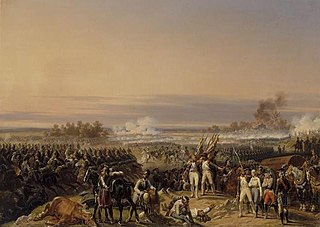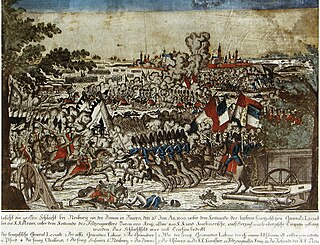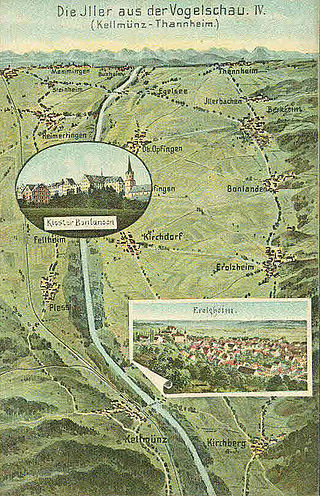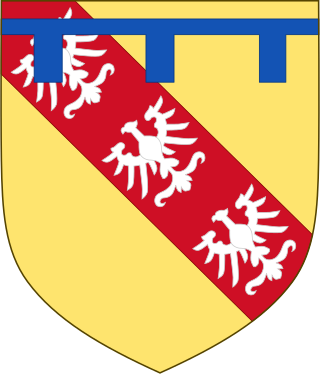
The Battle of Höchstädt was fought on 19 June 1800 on the north bank of the Danube near Höchstädt, and resulted in a French victory under General Jean Victor Marie Moreau against the Austrians under Baron Pál Kray. The Austrians were subsequently forced back into the fortress town of Ulm. Instead of attacking the heavily fortified, walled city, which would result in massive losses of personnel and time, Moreau dislodged Kray's supporting forces defending the Danube passage further east. As a line of retreat eastward disappeared, Kray quickly abandoned Ulm, and withdrew into Bavaria. This opened the Danube pathway toward Vienna.

The Battles of Stockach and Engen were fought on 3 May 1800 between the army of the First French Republic under Jean Victor Marie Moreau and the army of the Habsburg monarchy led by Paul Kray. The fighting near Engen resulted in a stalemate. However, while the two main armies were engaged at Engen, Claude Lecourbe captured Stockach from its Austrian defenders. The loss of his main supply base at Stockach compelled Kray to order a retreat. Stockach is located near the northwestern end of Lake Constance while Engen is 20 kilometres (12 mi) west of Stockach. The action occurred during the War of the Second Coalition, part of the French Revolutionary Wars.

The French Revolutionary Wars were a series of sweeping military conflicts resulting from the French Revolution that lasted from 1792 until 1802. They pitted France against Great Britain, Austria, Prussia, Russia, and several other countries. The wars are divided into two periods: the War of the First Coalition (1792–1797) and the War of the Second Coalition (1798–1802). Initially confined to Europe, the fighting gradually assumed a global dimension. After a decade of constant warfare and aggressive diplomacy, France had conquered territories in the Italian Peninsula, the Low Countries, and the Rhineland due to its very large and powerful military, which had been totally mobilized for war against most of Europe with mass conscription of the vast French population. French success in these conflicts ensured military occupation and the spread of revolutionary principles over much of Europe.

The War of the Second Coalition was the second war targeting revolutionary France by many European monarchies, led by Britain, Austria, and Russia and including the Ottoman Empire, Portugal, Naples and various German monarchies. Prussia did not join the coalition, while Spain supported France.
By 1799, the French Revolutionary Wars had resumed after a period of relative peace in 1798. The Second Coalition had organized against France, with Great Britain allying with Russia, Austria, the Ottoman Empire, and several of the German and Italian states. While Napoleon's army was still embroiled in Egypt, the allies prepared campaigns in Italy, Switzerland, and the Netherlands.

The Italian campaigns of the French Revolutionary Wars (1792–1801) were a series of conflicts fought principally in Northern Italy between the French Revolutionary Army and a Coalition of Austria, Russia, Piedmont-Sardinia, and a number of other Italian states.

Baron Paul Kray of Krajova and Topolya, was a soldier, and general in Habsburg service during the Seven Years' War, the War of Bavarian Succession, the Austro–Turkish War (1787–1791), and the French Revolutionary Wars. He was born in Késmárk, Upper Hungary.

The Siege of Genoa saw a Habsburg Austrian army led by General der Kavallerie Michael von Melas attack the port of Genoa defended by a Republican French army under General of Division (GD) André Massena. The action occurred in the Marengo campaign during the War of the Second Coalition. The Austrian army isolated Massena and half of the French army in Genoa, while driving off the other half of the army. Once Genoa was laid under siege, Massena conducted a very active defense with frequent sorties. Besieged on the land side by 24,000 Austrians led by Feldmarschall-Leutnant (FML) Peter Karl Ott von Bátorkéz and on the seaside by a Royal Navy squadron, famine reduced the defenders to starvation. By the time Massena surrendered the city on 4 June, many thousands of Genoa's residents died of starvation. While the Austrian army was focused on the siege, Napoleon Bonaparte's army invaded Italy from the northwest, ultimately winning the Battle of Marengo.

The Battle of Stockach occurred on 25 March 1799, when French and Austrian armies fought for control of the geographically strategic Hegau region in present-day Baden-Württemberg. In the broader military context, this battle constitutes a keystone in the first campaign in southwestern Germany during the Wars of the Second Coalition, part of the French Revolutionary Wars.

The Battle of Messkirch saw a Republican French army led by Jean Victor Marie Moreau attack a Habsburg Austrian army commanded by Paul Kray. At the start of the 1800 campaign in Germany, Moreau's 108,000-strong field army faced Kray's 120,000-man army on opposite sides of the Rhine River. By a series of maneuvers, Moreau crossed the Rhine and concentrated superior forces to defeat Kray at the Battles of Stockach and Engen on 3 May. After Kray retreated a short distance to the north, the two adversaries met again at Meßkirch. After a well-contested fight, Kray withdrew again, conceding victory to the French.

The Army of the Danube was a field army of the French Directory in the 1799 southwestern campaign in the Upper Danube valley. It was formed on 2 March 1799 by the simple expedient of renaming the Army of Observation, which had been observing Austrian movements on the border between French First Republic and the Holy Roman Empire. It was commanded by General Jean-Baptiste Jourdan, 1st Comte Jourdan (1762–1833).

At the Battle of Ampfing on 1 December 1800, Paul Grenier's two divisions of the First French Republic opposed the Austrian army southwest of the town of Ampfing during the French Revolutionary Wars. The Austrians, under the leadership of Archduke John of Austria, forced their enemies to retreat, though they sustained greater losses than the French. Ampfing is located 63 kilometers east of Munich and 8 km (5.0 mi) west of Mühldorf am Inn.

The Battle of Biberach on 9 May 1800 saw a French First Republic corps under Laurent Gouvion Saint-Cyr engage part of a Habsburg Austrian army led by Pál Kray. After an engagement in which the Austrians suffered twice as many casualties as the French, Kray withdrew to the east. The combat occurred during the War of the Second Coalition, part of the French Revolutionary Wars. Biberach an der Riss is located 35 kilometres (22 mi) southwest of Ulm.

The Battle of Neuburg occurred on 27 June 1800 in the south German state of Bavaria, on the southern bank of the Danube river. Neuburg is located on the Danube between Ingolstadt and Donauwörth. This battle occurred late in the War of the Second Coalition (1798–1802), the second war between Revolutionary France and the conservative European monarchies, which included at one time or another Britain, Habsburg Austria, Russia, the Ottoman Empire (Turkey), Portugal and Naples. After a series of reverses, several of the allies withdrew from the Coalition. By 1800, Napoleon's military victories in northern Italy challenged Habsburg supremacy there. French victories in the upper Danubian territories opened a route along that river to Vienna.

Antoine Digonet commanded a French brigade during the French Revolutionary Wars and Napoleonic Wars. He joined the French Royal Army and fought in the American Revolutionary War as a foot soldier. In 1792 he was appointed officer of a volunteer battalion. He fought the Spanish in the War of the Pyrenees and was promoted to general officer. Later he was transferred to fight French royalists in the War in the Vendée. In 1800 he was assigned to the Army of the Rhine and led a brigade at Stockach, Messkirch and Biberach. Shortly after, he was transferred to Italy. In 1805 he fought under André Masséna at Caldiero. He participated in the 1806 Invasion of Naples and led his troops against the British at Maida where his brigade put up a sturdy resistance. After briefly serving in the 1809 war, he took command of Modena and died there of illness in 1811. He never married.

The Convention of Alessandria was an armistice signed on 15 June 1800 between the French First Republic led by Napoleon and Austria during the War of the Second Coalition. Following the Austrian defeat at the Battle of Marengo, they agreed to evacuate Italy as far as the Mincio and abandon strongholds in Piedmont and Milan. Great Britain and Austria were allies and hoped to negotiate a peace treaty with France, but Napoleon insisted on separate treaties with each nation. The negotiations failed, and fighting resumed on 22 November 1800.

The Battle of Iller River or Battle of Erolzheim saw a French Republican army led by Jean Victor Marie Moreau fight a Habsburg Austrian army led by Paul Kray. In late May, the adversaries reached a stalemate with the Austrian army holding Ulm and the French army facing it from the south. Both armies numbered about 80,000 men. Kray launched an attack against the French left wing along the Iller River at Erolzheim and Illertissen, but he withdrew his troops when Moreau sent reinforcements. The action occurred during the War of the Second Coalition, part of the French Revolutionary Wars.

Joseph Maria Louis, Prince of Lorraine-Vaudémont served as an Austrian general during the French Revolutionary Wars. Born into a noble family in France, he went into exile in 1791 during the French Revolution and offered his services to the Habsburg monarchy. He fought in the Austrian army during the War of the First Coalition, rising in rank from leading a cavalry regiment to commanding a brigade. He led a division during the War of the Second Coalition and the War of the Third Coalition. He died in Hungary in 1812.

The Battle of Chiusella River or Battle of Romano saw the vanguard of a French Republican army led by First Consul Napoleon Bonaparte attack a Habsburg Austrian division led by Feldmarschall-Leutnant (FML) Karl Joseph Hadik von Futak. The action occurred in the Marengo campaign during the War of the Second Coalition. In May 1800, Bonaparte's Reserve Army crossed the Great St Bernard Pass into the Aosta Valley in northwestern Italy. Though its advance was delayed by Fort Bard, the Reserve Army's vanguard under General of Division (GD) Jean Lannes moved past the fort and captured Ivrea. Hadik attempted to block the French at the Chiusella River north of Romano Canavese. After a hard-fought action, the Austrians withdrew toward Turin. Hadik's battle report finally helped convince the Austrian army commander General der Kavallerie Michael von Melas that the main French threat was coming from the Aosta Valley.

The Marengo campaign saw a Habsburg Austrian army led by General der Kavallerie Michael von Melas fight against the defending French Army of Italy under General of Division (GD) André Massena and the invading French Reserve Army commanded by First Consul Napoleon Bonaparte. In early April, Melas launched a successful offensive that split the outnumbered Army of Italy and initiated the Siege of Genoa with Massena's forces trapped within the city. In mid-May, Bonaparte led the Reserve Army across the Great St Bernard Pass and into the Aosta Valley. After encountering a serious delay at Fort Bard, Bonaparte's forces broke into the plains of the Po Valley toward the end of May. At Turin, Melas blocked the direct route to Genoa, but Bonaparte's forces instead seized Milan and began severing the supply lines between Melas' army and Austria. After a long siege, Massena finally surrendered Genoa in early June, but by that time Melas' forces were isolated in northwest Italy. Melas tried to break out of the trap in the Battle of Marengo on 14 June 1800 and nearly succeeded because Bonaparte spread his army too thin. However, late-arriving troops defeated the Austrians and Bonaparte compelled Melas to evacuate northwest Italy as the price of a negotiated truce.






















